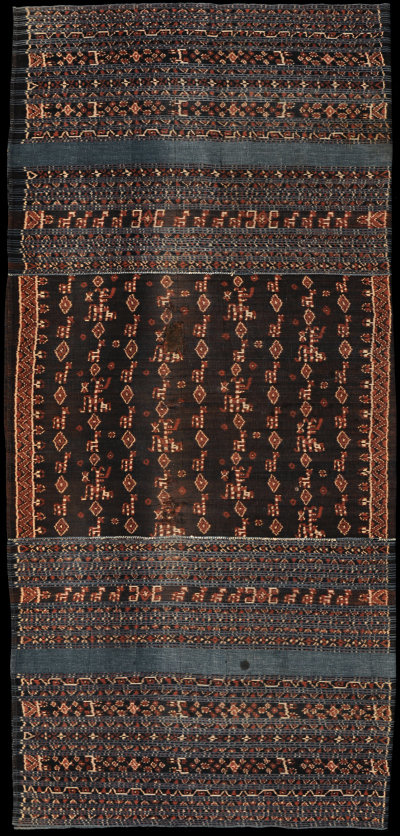| |
 
 | | | |
190 Flores Group, Ende
Zawo (sarong)  
| | | Period: | Circa 1850 (well before 1888) | | Yarn: | Cotton, hand-spun, fine | | Technique: | Weft ikat | | Panels: | 3 | | Size: | 155 x 171 cm (5' 1" x 5' 7") LW: 1.10 | | Weight: | 660 g (23.3 oz), 125 g/m2 (0.41 oz/ft2) | | Design: | Sarong, of a type called zawo jara ka'bi, for woman of the nobility. Central field decorated with diamonds and small horses, jara, alternated with gajah, elephants inspired by patola. Multiple narrower bands of ikat, interspersed with bands and pinstripes in pale indigo. Borders with patola-inspired zigzag motif. Cloth was opened up for display; size given refers to this state. This type of sarong was considered improper for weddings, and at a funeral, it would have been worn upside down because of Islam's taboo on depiction of living beings. | | Comment: | Old sarong with pattern reserved for high-ranking women. Ex collection Rita and René Wassing-Visser, who acquired it in 1980 from a lady, then 99 years old who inherited it along with other Indonesian artifacts from a great-uncle who lived in what was then the Dutch East Indies, and repatriated in 1888. By then the sarong must have been a few decades old already. Multiple signs of intensive wear: a stain of about one inch in one of the indigo bands, and a few old repairs, one executed by sewing in a small gauzey patch coloured to match the pattern. Colour still very lively. Repairs apart, in very good condition for its advanced age. | | Background: | Chapters on Flores Group and Ende. | | Published: | Ikat Textiles of the Indonesian Archipelago, 2018.
| | Compare: | 100 161 196 233 258 | | Sources: | Very similar to pre-1929 sarong in Vatter collection shown in Barnes, Ost-Indonesien im 20. Jahnhundert, Abb. 204, except that here the animals are more recognizable. Overall layout and tonality very similar to sarong on Abb. 206. Very similar to pre-1919 sarong in Tropenmuseum, Nr. TM-77-31. Similar to pre-1939 sarong in collection Lueth, depicted in Khan Majlis, Woven Messages, but with the addition in our example of the lion-like motifs and the pale indigo bands and pinstripes. Similar to early 20th C. sarong in Rautenstrauch-Joest Museum, Nr. 49808, depicted in Khan Majlis, Indonesische Textilien, Wege zu Goettern und Ahnen. Fig. 366. | | |

©Peter ten Hoopen, 2025
All rights reserved.
|
|


